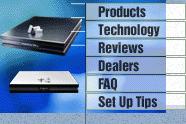
 |
 |
Technology |

 |
|
 |
Drainage Svelte Technology A Discussion
Technology: Mechanical Reactance
Rollerblock Systems Vs. Compliant Isolation Devices
Shortcomings of Compliant Material Isolation Devices
Low frequency vibration has been dealt with for many years with rubber pads and bumpers of sorbothane and similar materials. This technology has its roots in the automotive industry, and was developed as a less expensive substitute for springs, which were satisfactory for suspension of coaches and carriages for hundreds of years. However, the higher energy levels and frequencies of 20th century combustion engines and electric motors made springs undesirable in certain applications. Nevertheless, rubber, first synthesized from the South American plant of the same name in the 19th century, is widely used today in "high-end" audio and home theater applications as the primary method for "isolation" of vibration. However, while one technology may be satisfactory and even state of the art in one industrial arena, its successful transference to another discipline is neither guaranteed nor necessarily recommended. Such is the case with rubber and its synthetic descendants, such as sorbothane, when applied to vibration control in the present-day 21st century. These compliant materials achieve their goals through expansion and contraction in response to positional displacement of materials caused by vibratory energy. They may be used as feet, balls, pads, pods, rubber bands, "O-rings," or even as bags or tubes which are inflated with air. Regardless of shape, they all share the same characteristics: density change, and mechanical memory.Density Change and Mechanical Reactance
As these compliant materials compress or expand in order to compensate for positional displacement of the component, their densities change. Since mechanical energy transmission speed and other characteristics are directly affected by material density, the characteristics of such materials as sorbothane, rubber, compliant foams, etc. are constantly changing as a function of vibration. This complex and constantly changing condition is in essence a complex mechanical reactance which introduces a new set of colorations and distortions as it modulates the noise in the component.Constant-Density Bearing Isolation Devices
Ball bearing isolation devices do not suffer from this problem, since they account for positional displacement by rolling across a surface. At no time does the transmission path change as the ball rolls. Drainage pathway resistance is kept constant, and results are far more linear in all respects in comparison with compliant devices. The only potential problem with ball bearing isolation devices becomes bearing chatter, and the characteristics of the mechanical pathway, both of which are discussed below.Design Advantages of the Rollerblock System Symposium introduced the lateral plane (as opposed to single direction) ball bearing isolation device for use with audio and video components with the Rollerblock in 1997. The Rollerblock patent was the first to describe this device for use with active electronic components, and also the first to describe a ball in cup race. There are two basic engineering directives in ball bearing isolation technology: first, the device should create as little noise as possible, and second, it should preserve a proper mechanical transmission path through the device.
"Double Stack" (Top-And-Bottom-Sandwich) Ball Bearing Devices. The Symposium patent on the Rollerblock also specifically described and illustrated the "double cup" variation of this device, which is formed by utilizing two similar cup-type devices with a single ball between them. This dual cup or "Double Stack" variation is a Symposium invention, and since our initial patent and the introduction of the Rollerblock to the marketplace in 1997, much interest was spawned, both commercially and also as "Do It Yourself" devices described on the internet. While Symposium is gratified to see that its innovation has been so enthusiastically embraced by much of the audio community, it wishes to stress the design parameters which maintain the superiority of the Rollerblock design. While these parameters and the reasons for them are easily described, their realization in a real-world device is not as easily realized.
The purpose of a ball-bearing isolation device is simple and can be simply expressed: to reduce noise in the component. This is a subtractive process, and in order to be successful, the engineering choices must be those which operate without creating more distortion.
With that basic dictum in mind, here are some of the main features of Rollerblock technology which have dictated its design and evolution:
1. A single-ball-per-device system creates less noise than multiple-ball devices.
Any ball rolling on a surface creates noise; if all parameters (for instance, the smoothness of the ball and the smoothness of the "race" or rolling surface) are equal, single-ball devices will create less noise than multiple ball devices. Three balls will make three times as much noise as one ball. The fewer balls rolling, the less noise there will be, and the better results. For this reason, Symposium Rollerblock devices use the minimum number of balls - one.
2. A ball with a cup race is preferable to a ball with a flat surface race.
The purpose of a ball-bearing isolation device is to use up and dissipate mechanical energy (vibration) which would otherwise be transferred into the component it is isolating. Most vibratory energy is sinusoidal or cyclic in nature; that is, it starts at a zero point and goes through a positive and negative phase before returning to the rest position. On the way, the ball rolls in response to this displacement. While it rolls, it creates noise itself through contact with the race surface. In real-world bearing devices, there will be friction between the surface of the ball and the race. Since friction is noise, the isolation device itself becomes a secondary source of more distortion.
Cup-race devices (such as Rollerblocks) use up a greater part of the mechanical energy as work; flat-race devices can only dissipate mechanical energy as heat (friction). Putting a ball in a cup race forces the ball, upon displacement of the reference support, to try to "roll up" an incline. As it does so, it pushes the component or whatever it supports upward, accelerating a mass, and thus using up the energy primarily as work. For this reason, cup-race devices will generate less noise than flat-race devices, since they dissipate much of the unwanted mechanical energy without creating more noise. Flat-race devices often become coloration trading or resonance tuning devices, since by converting energy into noise, they trade one class of distortion for a new one. The cup-race device must also produce some noise (its ball is also rolling on a surface), but it is less in all cases for the same amount of displacement, since a good part of the energy is being used up as work. The noise issue also brings us to our next point:
3. The quality of the race surface is critical.
We have demonstrated that the less friction, the better the results, and the greater the effectiveness of the ball bearing isolation device. Therefore, the cup and ball should be as perfect and free from physical blemishes as possible. Symposium recognized this from the first; all Rollerblock devices have extremely uniform, "smooth" cups. The Series 2 Rollerblock has a cup race which is polished to optical tolerances for even better performance. The smoother the rolling surface, the quieter the rolling process.
4. The sphericity of the ball directly affects results.
Symposium was first in recognizing that ball sphericity was critical for state-of-the-art performance from a ball bearing isolation device. When the ball bearing device is actually working, the ball is oscillating. Any deviation from perfect roundness will induce a "wobble" in its oscillation which will worsen results. Currently, the most perfect ball grade available is Grade 3, which is defined as obeying certain parameters of perfection in roundness. The difference in performance between a Grade 3 "Superball" and a standard Grade 100 or even our high precision Grade 25 balls (supplied with all Rollerblock products) is significant and often shocking.
5. The relationship between ball size and cup sphericity is important.
This relationship determines system resonant frequency and mechanical path resistance, and influences ultimate results. Symposium settled on the specific relationship between its ball diameter and cup sphericity after experimentation which demonstrated that smaller balls reduce bass quality because of reduced transmission coupling (greater mechanical path resistance), and larger balls reduce high frequency resolving power because of greater mass (as in a loudspeaker diaphragm, the ball's mass loading causes slower transient response and determines high frequency response cutoff). While lighter balls have better transient response capability due to their lower mass, they also have less density and poorer coupling ability. There is a tradeoff between these two parameters, and the Rollerblock system preserves this relationship in an optimum relationship.
Wider or Greater Sphericity Cups
Wider or greater sphericity cups (that is, a cup which "approaches" a flat surface) and flat race devices tend to increase displacement capacity (rocking motion) of the component - that is, how far they can move - but this is of little tangible value in audio/video applications, because the displacement of vibratory energy in audio and video systems is on the order of thousandths to millionths of an inch. Ultimately, these devices suffer from increased noise problems as cited above, since they approach the "flat race" class of device. While the possible advantages of a lower resonant frequency realized by this approach may be considered as worthwhile for certain specific applications, this advantage is virtually cancelled out by the increase in frictional noise and increased instability, since a bearing device's ability to "rock" further than about 5 mm offers no meaningful advantages. Symposium has examined this aspect of the ball bearing device at length since 1996, and we have developed a solution which solves this problem. This has resulted in new technology which is the subject of a new patent application and will be announced and described soon.6. Material composition of ball and race is vital to overall results.
Race Material
It is important to maintain a good transmission path to ground out of the component for energy drainage (Please see our page on Cones for a discussion). The Rollerblock body thus becomes of importance as more than merely a receptacle for the ball; its makeup and material choices must be dictated by laws governing the transmission of mechanical energy. Mechanical transmission is analagous to electrical conductivity; the best are silver, copper, and aluminum, in that order. Of these, aluminum alloy presents an excellent, practical choice for a receptacle material, because of its hardness, machinability, and affordability.Ball Material
In experimenting with different types of balls, including aluminum, glass, brass, steel, ceramic, etc., we found that of all of them, Tungsten Carbide gave the best results. The reasons for this are again probably due primarily to the transmission quality of metal, which, because of its crystalline atomic structure, tends to transmit energy better than non-metallic materials. While Ceramic is marginally harder than Tungsten Carbide, it is not a good choice for a ball material, because its mechanical transmission characteristics are not as good as metal. Coffee cups are made of ceramic for a reason - it doesn't transmit heat very well.Tungsten Carbide is also the hardest currently machinable metal available (at an affordable price), and its high density is roughly twice that of chromium steel. Both these factors contribute directly to its high efficiency as the mediating conductor between component and race receptacle in maintaining good conductivity in the transmission pathway to mechanical ground.